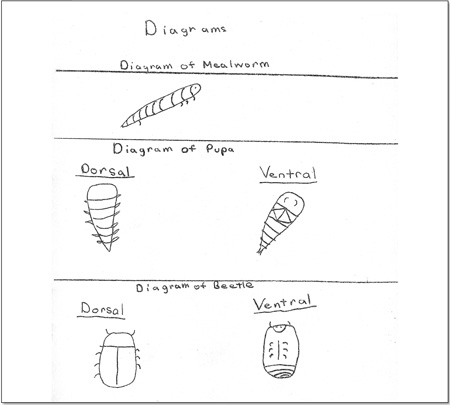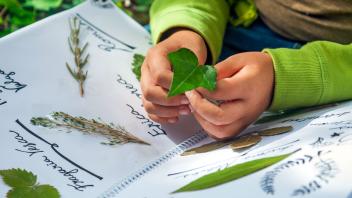Rationale
A science notebook, such as the one shown in the figure below, is a strategy for students to record and reflect on inquiry-based observations, activities, investigations, and experiments in order to increase their understanding of science instruction.
Science notebooks are also an excellent tool for students to communicate their understanding of science concepts, for teachers to provide students with feedback, and, finally, to assess students (Shepardson & Britsch, 2000, 2001).
Science notebooks are also a way for teachers to integrate science experiences with literacy and mathematics because they combine science inquiry, written communication, and data using measurement (Gilbert & Kotelman, 2005; Klentschy, 2005; Yore, Bisanz, & Hand, 2003).

Science notebook, behavior of mealworms, 3/4 grade
Science notebooks are modeled after the way scientists really work, and each scientist’s notebook is unique to that person, area of inquiry, type of experiment, and investigation. Student scientists record their observations, ideas, drawings, and other illustrations such as charts, tables, models, and graphs, along with their questions, ideas, and reflections in a running record of their thinking. A notebook may follow a general organization, but the contents can vary from student to student. Writing frames have also proven useful as prompts for students’ entries in their notebooks (Warwick, Stephenson, Webster, & Bourne, 2003).
Research has shown that science notebooks support differentiated instruction for English learners through the use of this open format and other useful strategies for teaching English learners such as tapping prior knowledge, the five senses, interaction in groups, and primary language support. (Amaral, Garrison, & Klentschy, 2002). Teachers can use science notebooks to conference with students for purposes of assessment and guidance (Aschbacher & Alonzo, 2006; Ruiz-Primo & Li, 2004).
Strategy
Introduce the use of science notebooks with children’s books that are based on the notebooks, journals, diaries, and records of scientists appropriate for each grade level. Discuss the books with students using reader response questions and prompts to engage them. Then model how to use a science notebook before, during, and after classroom science experiences, observations, and investigations.
A template can be used with students on a classroom chart, poster, or overhead transparency, with an individual copy for each student that includes the parts of a notebook — including places where students can formulate and develop their questions, make predictions, record observational data, describe procedures and results, write thoughtful reflections, and keep a record of the new concepts they are learning.
While each teacher will differentiate science notebook organization according to the grade level, interests, abilities, and individual needs of their students, here are the parts of science notebooks frequently used by teachers:
There are several ways to make science notebooks: in a composition book, a spiral notebook, a three ring binder with loose leaf paper and section dividers, or in a three-prong paper folder.
Writing frames can be provided for students to begin their entries, and they can bevaried by grade level. For example:
- “We are trying to find out …” (Grade 4)
- “We made the test fair by …” (Grade 4)
- “By carrying out these measurements we are able to find the connection between … and …” (Grade 6)
- “My results are accurate and reliable because …” (Grade 7)
Technology
Students can also word process notes and use drawing functions and other types of graphics on programs like Word, such as charts, graphs, tables, and so on. Older and more advanced students could keep an online science notebook and create a blog so other students in the class could comment on and compare their findings. In addition to using nonfiction literature to supplement observations and inquiries in a science notebook, students can do online research.
Find out more about science notebooks .
Grade-level modifications
K–2nd Grade
Introduce science notebooks on the weather by reading the fictional story Cloudy With a Chance of Meatballs (Barrett, 1978). This is a humorous story of a town where the weather comes at breakfast, lunch, and dinner in the form of food. It was recently made into a major motion picture. Discuss the book with reader response questions and prompts:
- What did you think of the weather in the book?
- What kind of weather can you imagine?
Other good read aloud books for pre-K or K are Like a Windy Day (Asch & Asch, 2008), When the Wind Stops (Zolotow, 1997), and The Storm Book (Zolotow, 1989); for K through 2 in general is Oh Say Can You Say What’s the Weather Today? All About the Weather (Cat in the Hat) (Rabe, 2004).
After modeling the use of science notebooks with students, plan daily observations of the weather. Students can note the date, time, and weather conditions, including measurements of the temperature using a thermometer, rainfall using a rain gauge, and wind using an anemometer. For younger students, record students’ spoken observations on a large wall chart or calendar. Students can also make their own observations, records, and reflections in an individual notebook. Students can add drawings, charts, graphs, comments, predictions, and questions in these science notebooks.
Bring students together to discuss what they observed and recorded in their notebooks, ask questions, pose problems, and continue with further inquiry about weather. With each change in the weather, read a nonfiction book about it, discuss it with students, do activities, and students can add to their notebooks. Make a list of weather words on a poster in the room and also give each student a list of the words to keep in their notebook. Students can add drawings and definitions and create a glossary for the notebook. A good introduction to weather words is the book Weather Words and What They Mean (Gibbons, 1992).
Recommended children’s books
- Like a Windy Day by Frank Asch
- Cloudy with a Chance of Meatballs by Judi Barrett
- Down Comes the Rain by Franklyn Mansfield Branley
- Flash, Crash, Rumble and Roll by Franklyn Mansfield Branley
- What Will the Weather Be? by Lynda DeWitt
- Feel the Wind by Arthur Dorros
- Sunshine by Alice Flanagan
- Wind by Alice Flanagan
- Clouds by Alice Flanagan
- Rain by Alice Flanagan
- Snow by Alice Flanagan
- Thunder and Lightning by Alice Flanagan
- Weather Words and What They Mean by Gail Gibbons
- Learning about Weather by Jo Ellen Moore
- W is for Wind by Pat Michaels
- Salamander Rain By Kristin Joy Pratt-Serafini
- Oh Say Can You Say, What’s the Weather Today? by Tish Rabe
- Clouds by Anne Rockwell
- The Storm Book by Charlotte Zolotow
- When the Wind Stops by Charlotte Zolotow
3rd Grade–5th Grade
Introduce keeping a science notebook by reading aloud the journals of famous scientists, such as Galileo’s Journal, 1609–1610 (Pettenati, 2006) and My Season With Penguins: An Antarctic Journal (Webb, 2000). Next, introduce keeping a science notebook on the behavior of mealworms by reading aloud the novel The Mealworm Diaries (Kerz, 2009), which is about two students working on a science project together and the personal problems they encounter while doing so. Lead a discussion about these books using reader response questions and prompts:
- As a scientist, what would you want to write about in your notebook?
- What are some things you have wondered about worms?
After modeling the use of a science notebook, provide mealworms for students to observe. Mealworms can be obtained from pet stores and biological supply houses. They can be kept in containers with a layer of bran and observed. Students can work in pairs to ask questions about mealworm behavior, pose hypotheses, collect and record data, make predictions, comment, and write reflections. Nonfiction books on mealworms can be used to supplement their observations of a living organism.
Recommended children’s books
- A Mealworm’s Life by John Himmelman
- The Mealworm Diaries by Anna Kerz
- Mealworms by Adrienne Mason
- Galileo’s Journal by Jeanne Pettenati
- Mealworms by Martha Rustad
- From Mealworm to Beetle by Laura Purdie Salas
- Mealworms by Donna Schaffer
- My Season with Penguins by Sophie Webb
English language learners
English language learners can use visuals such as drawings, tables, graphs, charts, or models instead of language to make their ideas concrete and to demonstrate their understandings in a nonlinguistic way. Science notebooks also rely on the use of the five senses, tapping into prior knowledge — also excellent strategies for English language learners. Group discussions of science notebooks also provide teacher to student or student to student interaction, including the use of primary language support.
Books in students’ primary language related to the topic of the science notebook canalso be used.
Recommended children’s books
- No Necesito Paraguas/I Don’t Need an Umbrella by Amy White
Struggling students
Writing frames for science notebook entries modeled by the teacher and co-created with students provide excellent scaffolding for struggling students or students with disabilities. The use of visual entries such as drawings, charts, graphs, diagrams, models,and so on also allow students to make entries even if they are struggling with writing.
Take dictation related to these drawings, and so forth, for students to model the writing down of their observations and ideas. A list of the science vocabulary needed for the notebooks can be posted in the room and each student provided with a copy, and materials used for the science notebooks can be labeled so that students can copy the words into their notebooks when needed.
Writing frames for science notebook entries can be posted in the room or on a copy for each student:
- “I observed …”
- “I (saw, smelled, felt, heard) …”
- “My (experiment, investigation) was …”
- “I found that …”
- “I think this because …”
Assessment
Student science notebooks can be assessed, at a minimum, for organization and completeness according to the following rubric:
| Content | Criteria |
Score |
Comments / Suggestions |
|---|---|---|---|
| Table of contents | All parts included Page numbers indicated |
||
| Organization | Titles of activity or section All dates and times All pages numbered |
||
| Written entries and reflections | Appropriately titled Includes main ideas Provides necessary details Shows understanding |
||
| Illustrations: drawings, graphs, charts, tables, diagrams, etc. |
Titled and labeled Supports ideas |
With younger students, science notebooks can be an excellent tool to assess student performance, understanding, and needs in a conference. Peer-conferences and peer-assessment using the rubric can be used in Grades 3 through 8, along with periodic conferences where questions can be asked and answered and a dialogue can be shared about the contents of the science notebook.
Resources
Campbell, B., & Fulton, L. (2003). Science notebooks: Writing about inquiry. Portsmouth, NH: Heinemann.
Cox, C. (2012). Literature Based Teaching in the Content Areas. Thousand Oaks, CA: SAGE Publications, Inc.
